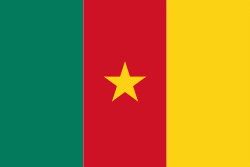Lebialem
Lebialem is a department of Southwest Province in Cameroon. The department covers an area of 617 km2 and as of 2005 had a total population of 113,736. The capital of the department lies at Menji. Lebialem got its name from the Lebialem Falls, a twin water fall, which means ' a hill from which water drops '. The county is dominated by two ethnic groups, the Mundani to the north and the Bangwa to the south (ba meaning people of), though other ethnic groups exists, the makeup a minority, example the Mbo, Banyangi and Bamiléké.
Since the outbreak of the Anglophone Crisis in 2017, much of Lebialem has come under the control of the Red Dragon militia, which were led by Lekeaka Oliver until he was shot dead on July 12, 2022. In October 2019, after forcing traditional rulers to flee, Oliver declared himself "Paramount Ruler of Lebialem". As of May 2020, much of Lebialem district is under the control of Oliver and his Red Dragon militia.
The department is divided administratively into 3 districts and in turn into 17 villages or Fundons.
Since the outbreak of the Anglophone Crisis in 2017, much of Lebialem has come under the control of the Red Dragon militia, which were led by Lekeaka Oliver until he was shot dead on July 12, 2022. In October 2019, after forcing traditional rulers to flee, Oliver declared himself "Paramount Ruler of Lebialem". As of May 2020, much of Lebialem district is under the control of Oliver and his Red Dragon militia.
The department is divided administratively into 3 districts and in turn into 17 villages or Fundons.
Map - Lebialem
Map
Country - Cameroon
 |
 |
| Flag of Cameroon | |
Early inhabitants of the territory included the Sao civilisation around Lake Chad, and the Baka hunter-gatherers in the southeastern rainforest. Portuguese explorers reached the coast in the 15th century and named the area Rio dos Camarões (Shrimp River), which became Cameroon in English. Fulani soldiers founded the Adamawa Emirate in the north in the 19th century, and various ethnic groups of the west and northwest established powerful chiefdoms and fondoms. Cameroon became a German colony in 1884 known as Kamerun. After World War I, it was divided between France and the United Kingdom as League of Nations mandates. The Union des Populations du Cameroun (UPC) political party advocated independence, but was outlawed by France in the 1950s, leading to the national liberation insurgency fought between French and UPC militant forces until early 1971. In 1960, the French-administered part of Cameroon became independent, as the Republic of Cameroun, under President Ahmadou Ahidjo. The southern part of British Cameroons federated with it in 1961 to form the Federal Republic of Cameroon. The federation was abandoned in 1972. The country was renamed the United Republic of Cameroon in 1972 and back to the Republic of Cameroon in 1984 by a presidential decree by president Paul Biya. Paul Biya, the incumbent president, has led the country since 1982 following Ahidjo's resignation; he previously held office as prime minister from 1975 on. Cameroon is governed as a Unitary Presidential Republic.
Currency / Language
| ISO | Currency | Symbol | Significant figures |
|---|---|---|---|
| XAF | Central African CFA franc | Fr | 0 |
| ISO | Language |
|---|---|
| EN | English language |
| FR | French language |















